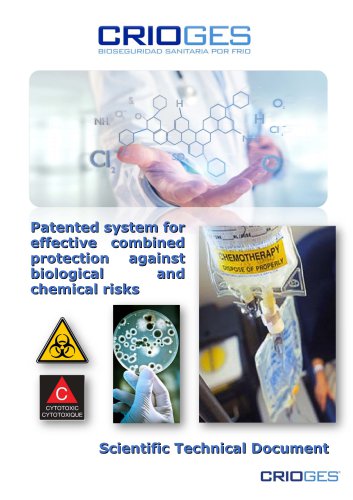
Catalog excerpts
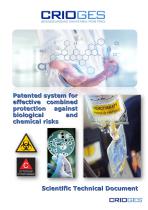
Patented system for effective combined protection against biological and chemical risks Scientific Technical Document
Open the catalog to page 1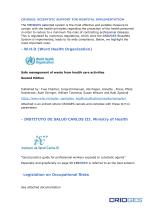
CRIOGES: SCIENTIFIC SUPPORT FOR HOSPITAL IMPLEMENTATION The CRIOGES patented system is the most effective and suitable measure to comply with the health principles regarding the protection of the health personnel in order to reduce to a minimum the risks of contracting professional diseases. This is regulated by numerous regulations, which once the CRIOGES Biosafety System is implemented, leads to its wide compliance. Below, we highlight the most important ones: - W.H.O (Word Health Organization) Safe management of waste from health care activities Second Edition Published by: Yves...
Open the catalog to page 2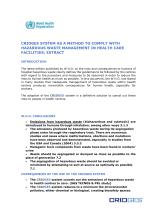
CRIOGES SYSTEM AS A METHOD TO COMPLY WITH HAZARDOUS WASTE MANAGEMENT IN HEALTH CARE FACILITIES: EXTRACT INTRODUCTION: The latest edition published by W.H.O. on the risks and consequences to humans of hospital hazardous waste clearly defines the guidelines to be followed by the centres with regard to the procedure and measures to be observed in order to reduce the risks to human health as much as possible. In this document, the W.H.O. has stated in many studies that inadequate management of hazardous waste within health centres produces irreversible consequences for human health, especially...
Open the catalog to page 3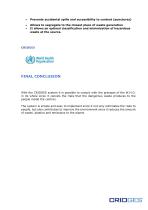
Prevents accidental spills and accessibility to content (punctures) Allows to segregate to the closest place of waste generation It allows an optimal classification and minimization of hazardous waste at the source. FINAL CONCLUSION With the CRIOGES system it is possible to comply with the precepts of the W.H.O. in its whole since it cancels the risks that the dangerous waste produces to the people inside the centres. The system is simple and easy to implement since it not only eliminates the risks to people, but also contributes to improve the environment since it reduces the amount of...
Open the catalog to page 4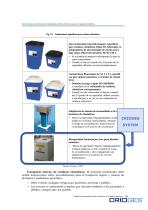
CRIOGES SYSTEM
Open the catalog to page 6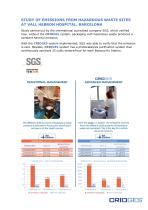
STUDY OF EMISSIONS FROM HAZARDOUS WASTE SITES AT VALL HEBRON HOSPITAL. BARCELONA Study carried out by the international accredited company SGS, which verified how, without the CRIOGES system, packaging with hazardous waste produces a constant harmful emission. With the CRIOGES system implemented, SGS was able to verify that the emission is zero. Besides, CRIOGES system has a photocatalysis purification system that continuously sanitizes 35 cubic meters/hour for each Biosecurity Station.
Open the catalog to page 7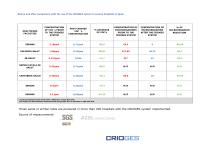
Before and after comparison with the use of the CRIOGES system in several hospitals in Spain CONCENTRATION OF VOC´s PRIOR TO THE CRIOGES SYSTEM POST CRIOGES VOC ´s CONCENTRATION CONCENTRATION OF MICROORGANISMS PRIOR TO THE CRIOGES SYSTEM CONCENTRATION OF MICROORGANISMS AFTER THE CRIOGES SYSTEM VALENCIA SALUT SERVEI CATALA DE SALUT CANTABRIA SALUD HEALTHCARE FACILITIES * Contrast measurements made with a difference of less than 24h. The longer the time between measurements the greater the % decrease in AMA and MLA. These same or similar rates are produced in more than 200 hospitals with the...
Open the catalog to page 8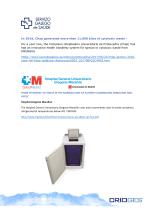
In 2016, Chop generated more than 11,000 kilos of cytotoxic waste For a year now, the Complexo Hospitalario Universitario de Pontevedra (Chop) has had an innovative health biosafety system for special or cytotoxic waste from CRIOGES https://www.lavozdegalicia.es/noticia/pontevedra/2017/06/22/chop-genero-2016once-mil-kilos-residuos-citotoxicos/0003_201706P22C4993.htm FROM YESTERDAY TO TODAY IN THE NURSING CARE OF PATIENTS UNDERGOING DEBULKING AND HYPEC Hospital Gregorio Marañon The Hospital General Univesitario Gregorio Marañón uses and recommends class VI waste containers, refrigerated at...
Open the catalog to page 9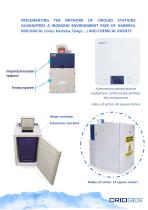
IMPLEMENTING THE NETWORK OF CRIOGES STATIONS GUARANTEES A WORKING ENVIRONMENT FREE OF HARMFUL BIOLOGICAL (virus, bacteria, fungi, ...) AND CHEMICAL AGENTS Autonomous photocatalysis equipment, continuously sanitizes the environment radius of action: 40 square meters Waste container Emissionss canceled Radius of action: 14 square meters
Open the catalog to page 11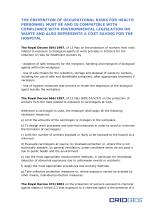
THE PREVENTION OF OCCUPATIONAL RISKS FOR HEALTH PERSONNEL MUST BE AND IS COMPATIBLE WITH COMPLIANCE WITH ENVIRONMENTAL LEGISLATION ON WASTE AND ALSO REPRESENTS A COST SAVING FOR THE HOSPITAL The Royal Decree 664/1997, of 12 May on the protection of workers from risks related to exposure to biological agents at work provides in Article 6 for the reduction of risks for healthcare workers by - Adoption of safe measures for the reception, handling and transport of biological agents within the workplace - Use of safe means for the collection, storage and disposal of waste by workers, including...
Open the catalog to page 12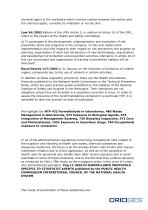
chemical agent in the workplace which involves contact between the worker and the chemical agent, normally by inhalation or via the skin. Law 54/2003 Reform of the LPRL Article 5, in relation to Article 16 of the LPRL, refers to the powers of the Health and Safety Committee. a) To participate in the development, implementation and evaluation of risk prevention plans and programs in the company. To this end, before their implementation and with regard to their impact on risk prevention, the projects on planning, organization of work and introduction of new technologies, organization and...
Open the catalog to page 13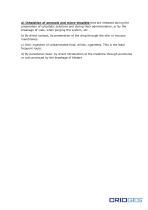
a) Inhalation of aerosols and micro-droplets that are released during the preparation of cytostatic solutions and during their administration, or by the breakage of vials, when purging the system, etc. b) By direct contact, by penetration of the drug through the skin or mucous membranes. c) Oral: ingestion of contaminated food, drinks, cigarettes. This is the least frequent route. d) By parenteral route: by direct introduction of the medicine through punctures or cuts produced by the breakage of blisters
Open the catalog to page 14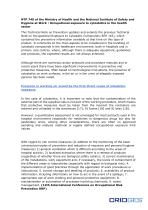
NTP 740 of the Ministry of Health and the National Institute of Safety and Hygiene at Work : Occupational exposure to cytostatics in the health sector This Technical Note on Prevention updates and extends the previous Technical Note on Occupational Exposure to Cytostatic Compounds (NTP 163), which contained the preventive information available at that time on this type of product. It comments on the main aspects to be considered in the handling of cytostatic compounds in the healthcare environment, both in hospitals and in primary care centres, where, although there is adequate equipment,...
Open the catalog to page 15
